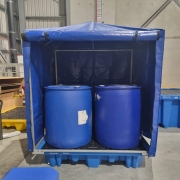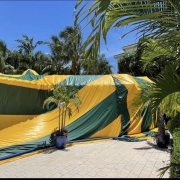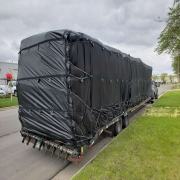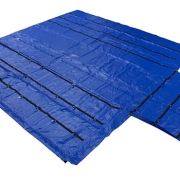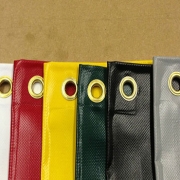Discover the top benefits of using IBC pallet tarps for industrial storage. Learn how waterproof, UV-resistant covers protect your IBC tanks, drums, and pallets.
Introduction
In industrial environments,Intermediate Bulk Containers (IBCs) are widely used to store and transport liquids,chemicals,and food products.
However,exposure to sunlight,dust,and moisture can damage IBCs, leading to contamination, corrosion, or material degradation.
That’s why more warehouses and factories are turning to IBC pallet tarps — durable,waterproof PVC Tarpaulin covers that provide long-lasting protection for palletized containers.
In this article, we’ll explore the Top 5 Benefits of using IBC Pallet Tarps in industrial storage, and why they’re essential for keeping your assets safe,clean,and compliant.
1. Weatherproof Protection from Rain, Snow, and UV
The biggest threat to IBC containers stored outdoors is exposure to the elements.
IBC pallet tarps made from PVC-coated polyester fabric offer full protection against:
- Rain and humidity, which can cause rust or leakage.
- Direct sunlight, which weakens plastic IBC walls and caps.
- Extreme temperatures, keeping your liquids stable during seasonal changes.
✅With UV-stabilized coatings and waterproof welding seams, Bollison’s IBC pallet tarps are engineered to withstand long-term outdoor use — no matter the climate.
2. Prevents Contamination and Product Loss
Uncovered IBCs can quickly accumulate dust, dirt, insects, or bird droppings, contaminating the product inside.
IBC pallet tarps form a protective barrier that prevents:
- Contaminants from entering tank openings.
- Rainwater pooling or mold growth.
- Product degradation due to prolonged exposure.
✅By maintaining a clean, sealed environment, you extend the lifespan of both the IBC and the product it stores — saving money and ensuring safety compliance.
3. Extends the Lifespan of IBC Containers
Continuous exposure to UV radiation and moisture accelerates material aging, causing:
- Brittle plastic surfaces,
- Cracks in container caps or lids,
- Rust on steel frames and pallets.
✅IBC pallet tarps minimize these risks by blocking UV light and shielding against rain or snow, helping your containers last 2–3 times longer.
✅This not only lowers replacement costs but also reduces waste and improves sustainability.
4. Increases Operational Efficiency and Safety
IBC pallet covers are not just for protection — they also streamline daily operations.
- Workers can quickly identify container contents with color-coded or printed covers.
- Properly covered IBCs reduce spills, leakage, and slip hazards.
- Tarps with Velcro closures or zippers allow fast access during filling or discharge.
✅Whether in warehouses or open loading yards, IBC pallet tarps make handling and logistics safer, cleaner, and more organized.
5. Reusable, Cost-Effective, and Environmentally Friendly
Unlike disposable plastic wraps or shrink films, PVC IBC pallet tarps are fully reusable and recyclable.
They offer excellent return on investment by reducing material waste and operating costs:
- Designed for multi-year use.
- Easy to clean and maintain.
- Reduces plastic waste in industrial storage applications
✅Using durable, reusable covers supports eco-friendly storage management and aligns with modern sustainability goals.
Bonus: Custom Options for Every Industry
Modern IBC pallet tarps can be customized for various applications:
- Insulated tarps for temperature-sensitive liquids.
- Printed covers with company logos or handling instructions.
- Ventilated designs for non-liquid or food storage.
✅These customization options enhance brand visibility and operational efficiency at once.
✅ Conclusion
From weather protection to cost savings, IBC pallet tarps are an essential investment for any business that stores or transports bulk liquids and chemicals.
By shielding your IBCs from external elements and maintaining product integrity, you can significantly reduce maintenance costs, improve safety, and extend the usable life of your equipment.

